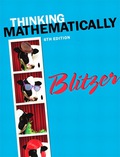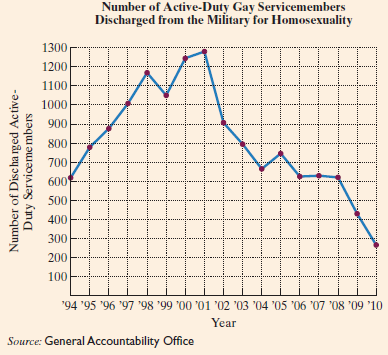
Concept explainers
The stated intent of the 1994 “don’t ask, don’t tell” policy was to reduce the number of discharges of gay men and lesbians from the military. Nearly 14,000 active-duty gay servicemembers were dismissed under the policy, which officially ended in 2011, after 18 years. The line graph shows the number of discharges under “don’t ask, don’t tell” from 1994 through 2010.

a. For the period shown, in which year did the number of discharges reach a maximum? Find a reasonable estimate of the number of discharges for that year.
b. For the period shown, in which year did the number of discharges reach a minimum? Find a reasonable estimate of the number of discharges for that year.
c. In which one-year period did the number of discharges decrease at the greatest rate?
d. In which year were approximately 1000 gay service-members discharged under the ‘don’t ask, don’t tell” policy?
Want to see the full answer?
Check out a sample textbook solution
Chapter 1 Solutions
EBK THINKING MATHEMATICALLY
- Are the two statements A and B equivalent? (A) p~q (B) ~pq ☐ Statement A and B are equivalent. ☐ Statement A and B are not equivalent as their values in three rows are not identical. ☐ Statement A and B are not equivalent as their values in one row is not identical. ☐ Statement A and B are not equivalent as their values in two row are not identical.arrow_forwardLet p, q and r to be True, False and True statements, respectively. What are the values of the statements below. A: B: [(p→q)^~q]→r (pvq) → ~r O O A: False B: False A: True B: True A: False B: True A: True B: Falsearrow_forwardLet's assume p and q are true statements. What are the values of the statements below. A: (p→ q) →~p B: (p v~q) → ~(p^q) A: True B: False A: True B: True ☐ A: A: False B: False ☐ A: False B: Truearrow_forward
- Three statements A, B and C are given below. Which choice is correct? (A) ~(p^~q) (B) ~p^q (c) pv~q ☐ All statements are inequivalent. ☐ Only statements A and B are equivalent. ☐ Only statements C and B are equivalent. ☐ Only statements A and C are equivalent.arrow_forward6: 000 Which truth table is correct for the given compound statement? (pvq)^p]→q A: B: P P 9 [(pvq)^p]→ 9 T T F T T T T F T T F F F T T F T F F F T F F T C: P 9 [(pvq)^p]→9 D: P 9 [pvq)^p]→9 T T T T T T TF T T F F F T F F T T F F F F F T B A D Previous Page Next Page Page 3 of 11arrow_forwardst One Which truth table is correct for the given compound statement? (p→q)^~p A: P q (p→q)^~p B: P q (p→q)^~p T T F T T F T F F T F T F T T F T T F F F F F T C: D: P q (p→ q)^~p P 9 (p→q)^~p T T F T T T T F F T F F F T T F T T F F T F F T A U Oarrow_forward
 Glencoe Algebra 1, Student Edition, 9780079039897...AlgebraISBN:9780079039897Author:CarterPublisher:McGraw Hill
Glencoe Algebra 1, Student Edition, 9780079039897...AlgebraISBN:9780079039897Author:CarterPublisher:McGraw Hill Algebra: Structure And Method, Book 1AlgebraISBN:9780395977224Author:Richard G. Brown, Mary P. Dolciani, Robert H. Sorgenfrey, William L. ColePublisher:McDougal Littell
Algebra: Structure And Method, Book 1AlgebraISBN:9780395977224Author:Richard G. Brown, Mary P. Dolciani, Robert H. Sorgenfrey, William L. ColePublisher:McDougal Littell Holt Mcdougal Larson Pre-algebra: Student Edition...AlgebraISBN:9780547587776Author:HOLT MCDOUGALPublisher:HOLT MCDOUGAL
Holt Mcdougal Larson Pre-algebra: Student Edition...AlgebraISBN:9780547587776Author:HOLT MCDOUGALPublisher:HOLT MCDOUGAL Big Ideas Math A Bridge To Success Algebra 1: Stu...AlgebraISBN:9781680331141Author:HOUGHTON MIFFLIN HARCOURTPublisher:Houghton Mifflin Harcourt
Big Ideas Math A Bridge To Success Algebra 1: Stu...AlgebraISBN:9781680331141Author:HOUGHTON MIFFLIN HARCOURTPublisher:Houghton Mifflin Harcourt



